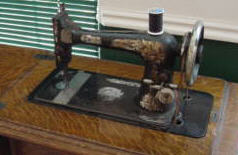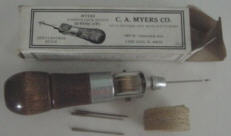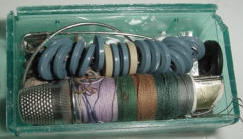
* Sewing *
By serger
Keeping things together
I suppose with my handle being such as it is you would think I know a great deal about sewing but in actuality I am not Edith Head by any means. What Iím going to discuss is my sewing equipment. Itís not overly sophisticated but it serves me well. The impetus for this article was my need to have the nylon retainer strap extended in my laptop computer case that Velcros the laptop into it.
I asked my wife to sew it up for me but sheís bogged down with finals the next two weeks and she said sheíd do it when she "got to it." That translated to me to be after graduation the end of May. Being the impatient type I am I couldnít wait and had to break out the pocket knife for a seam ripper to remove the hook section of Velcro off the hold down strap and start uncovering the treadle sewing machine.

My paternal grand mother had a Singer model 15 sewing machine she took in laundry to get the money to buy. Most of my fatherís clothes were sewn on it until he got a job at the age of ten so he could buy clothing and not look like "Oil Field Trash". After she died I ended up with the machine because I was the only one out of the grandkids who tried to keep it oiled and didnít actively try and tear it up. The original furniture was trashed and I found a nice cabinet at a flea market and now the head resides in it.
Itís one of those leather belt driven straight stitch pump it with your foot machines. It should be lubricated with sewing machine oil but according to the manual you can down load in PDF format from Singer you can use kerosene in a pinch. I have all the attachments for button holer, ruffler and French seam and pleating things but now days all I sew on it are really heavy strapping and fabrics. The hand pulley on the right is great for slowly muscling a needle through heavy canvas or in the case of the laptop strap heavy nylon webbing.
For me itís the male equivalent of what I see many women look for in a car. You put thread in here, Adjust the feed here, adjust the thread here, put fabric in here and start rolling the hand wheel to get it going. Face it guys, most gals could care less if you have a 1968 Stingray with a 427 and Tri Power carb in it. All she wants to know is where to put the gas, where the ignition switch is and how to shift it when her foot ainít on the gas or brake. These old treadle machines are built like tanks and if you have a sharp needle and the right thread they will sew anything, up to and including 5oz. top grain leather. Youíll just have to roll the needle by hand.
The trick of the whole deal is to keep the presser foot adjustment right and have the thread tension set up so it sews with an interlocking stitch and not a basting stitch. With out boring you with details an interlocking stitch is one where the two threads balance themselves such that the loops where they interlock are mirror images of each other. A basting stitch is one where one thread is more or less straight and the other one loops through the material being sewn and back to the other side. Anyone who has unloaded livestock feed knows a basting stitch. (or if you buy bulk beans youíve seen it).
They are still to be found for a reasonable amount of money from the newspaper, flea market or even antique store. And since they are built very tough about all you need is to keep them oiled properly and have lots of the right type of supplies (needles, thread and fabric) to keep it going and your grand kids will be playing with yours.
Lehmans non-electric catalog has treadle sewing machines for sale. They are expensive and I canít vouch for them but I know they got em. But in the best traditions of a cheap scrounger Iíd go to the local flea market and look for an original Singer or White and be happy.

The next item is my Stitching Awl. You can buy these at the hardware store. Iím not talking at Lowes or Builders Square Or Payless Cashways, Iím talking an honest to goodness hardware store. One that has a wooden floor and canning supplies as well as nails and bait. They are still under $15.00. If you donít have a hardware store then go here and Tandy Leather will hook you up. With one of these, several needles and a supply of thread you can make just about any type of heavy baggage or equipage you might need. My father made a set of panniers for hunting with his because the store bought kind werenít deep enough for the ten-day hunts he went on. Iíve built more leather knife sheaths than I can remember with mine. I also know people in West Texas who have an heirloom saddle that was made with a sewing awl, ground down nail for a fid and a sewing palm. The stitching pony was made from two barrel staves with an iron rod to tension them.
I think I lost a few people with that one, let me explain. A Fid is a glorified ice pick that is used to enlarge holes in material to allow the stitching easy passage through. So what you can do is poke the holes with the fid and then use the stitching awl to sew it up. This saves on the awls needle. A Sewing Palm is a piece of heavy leather that has a strap your hand fits into. You use it to push the needle through the work and to back the work up while pressing the awl through it. You can think of it as a thimble for your hand. The needle works on the leather instead of your skin. A Stitching Pony is a device that uses two pieces of upright wood or metal to hold the work like a vice at a convenient height so you can sew. What you do is to place the work in the jaws of the pony and screw them down then you can sew the pieces together and not have to juggle between holding the work and sewing at the same time.
While Iím on sewing really heavy things hereís a trick I learned. You can take a key from a metal can and when youíre done opening it take it and pound it out straight. Then take and file the end without the slot into a long point. You now have a heavy-duty needle to sew up things that need heavy-duty sewing.

My last bit of sewing stuff is my sewing kit that lives in my shaving kit. It is made out of a small ammunition box (CCI Stinger box) that holds several needles, thread, a thimble, and various buttons. I put it together while in the Navy to sew on/up things that needed sewing. There are various colored threads and buttons. It has a large curved needle that is very useful for sewing things like daypacks and duffle bags and dungarees. For really heavy-duty sewing I use the dental floss in the shaving kit. Itís waxed and extremely tough. I have several pieces of gear that were sewn with floss years ago and still are working fine. The only down side to this is the floss I use is white. When I sewed my black daypack you could see the threads. But I know they will not fail me.
Thatís my sewing stuff. Thanks for the read.
serger
All materials at this site not otherwise credited are Copyright (c) 1996-2002 Trip Williams. All rights reserved. May be reproduced for personal use only. Use of any material contained herein is subject to stated terms or written permission.